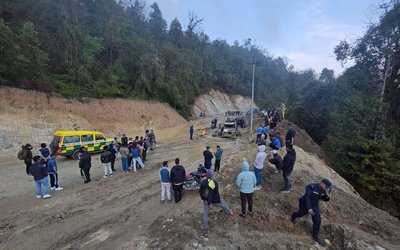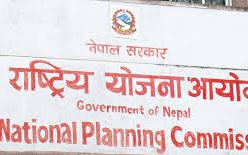
BY ROBERT MYLES
If greenhouse-gas emissions continue to rise, glaciers in the Everest region of the Himalayas could experience dramatic changes in the decades to come.
A team of researchers drawn from Nepal, France and the Netherlands say Everest glaciers could be very sensitive to future warming, and that sustained ice loss through the 21st century is likely.
An international research team suggest glaciers in the Everest region of the Himalayas could see a 70 percent decline in volume by the end of this century if greenhouse gas emissions continue their upward trend.
According to the scientists, the dramatic change predicted will be brought about because Everest’s glaciers are extremely sensitive to temperature changes making sustained ice loss likely during the remaining 85 years of this century.
The Mera Glacier region in the Dudh Kosi basin Nepal. One of the areas studied by the research team...
The Mera Glacier region in the Dudh Kosi basin, Nepal. One of the areas studied by the research team.
Patrick Wagnon - European Geosciences Union
A research team led by Joseph Shea, a glacier hydrologist at the International Centre for Integrated Mountain Development (ICIMOD), Kathmandu, Nepal, used glacier modelling to predict future losses in glacier volume. The results depended on just how much the level of greenhouse gases in Earth’s atmosphere continue to rise and the knock-on effect this would have on temperature, snowfall and rainfall in the area. Their best case prediction was a 70 percent loss in glacier volume but, at worst, glaciers in the Everest region could all but disappear with 90 percent of the ice gone by 2100.
“The signal of future glacier change in the region is clear: continued and possibly accelerated mass loss from glaciers is likely given the projected increase in temperatures,” said Shea, adding, “Our results indicate that these glaciers may be highly sensitive to changes in temperature, and that increases in precipitation are not enough to offset the increased melt.”
Increased temperatures would produce a negative feedback effect since not only would the rates of snow and ice melt increase, but higher temperatures would also produce a change in precipitation causing rain to fall, rather than snow, at critical altitudes where most of the Everest glaciers are located. The decline in snowfall would mean glacier growth is curtailed with an increased area of each glacier being exposed to melt.
Glaciers in an area known as High Mountain Asia, which encompasses the Everest region and the Himalayas, contain the largest volume of ice on Earth apart from the Arctic and Antarctic.
Researchers examined glaciers in the Dudh Kosi basin in the Nepal Himalaya. Some of the world’s highest mountain peaks, Mount Everest included, are found in this area while the basin contains over 400 square kilometers of glacier area.
It’s not just the disappearance of the glaciers themselves that’s a concern. Shea suggested glacier melt would have an impact on communities at lower altitudes, explaining, “Apart from the significance of the region, glaciers in the Dudh Kosi basin contribute melt-water to the Kosi River, and glacier changes will affect river flows downstream.”
Changes in glacier volume would have a two-fold impact on Nepalese communities. Up till now these communities were able to rely on what has generally been a steady flow of glacier melt-water for use in agriculture and hydro-power during warmer months, a time when rainfall can be sparse before the Monsoons arrive.
But while increased glacier melt would initially increase water-flows, further out, due to glaciers retreating, the flow of melt-water would reduce. A further possible impact could be the formation and growth of lakes of melt-water, the result of glacial debris washed downstream and damming the flow of water.
As recent events have demonstrated to devastating effect, Nepal lies in an earthquake zone and both earthquakes and avalanches could cause such glacial dams to sunder. Such breaches would cause catastrophic floods with river flows 100 times greater than normal in the Kosi basin.
The team’s research into the predicted evolution of these Himalayan glaciers commenced with field observations and data from local weather stations to calibrate and test a model of glacier change over the past 50 years.
“To examine the sensitivity of modeled glaciers to future climate change, we then applied eight temperature and precipitation scenarios to the historical temperature and precipitation data and tracked how glacier areas and volumes responded,” says study co-author Walter Immerzeel of Utrecht University in the Netherlands.
How glaciers react to temperature has much to do with the altitude at which water freezes. Presently, the elevation where temperatures are below 0° Celsius varies between 3200 meters in January to 5500 meters in August. But according to Immerzeel, “Based on historical temperature measurements and projected warming to the year 2100, this could increase by 800 to 1200 meters.”
“Such an increase would not only reduce snow accumulations over the glaciers, but would also expose over 90 percent of the current glacierized area to melt in the warmer months,” he added.
One of the research team, Patrick Wagnon, a visiting scientist at ICIMOD and glaciologist at the Institut de Recherche pour le Développement in Grenoble, France, emphasized, however, that these initial estimates be considered a first approximation to how Himalayan glaciers will react to increasing temperatures, stating that “considerable uncertainties remain.” He cited the example of the researchers’ model simplifying the movement of glaciers which, in turn, affects how glaciers respond to increases in temperature and precipitation.
But the researchers stressed that “the signal of future glacier change in the region is clear and compelling” with decreases in ice thickness and extent expected for “even the most conservative climate change scenario.”
For Nepal, a country that has suffered so much of late, that warning does not bode well.
Details of their research, entitled, ‘Modelling glacier change in the Everest region, Nepal Himalaya,’ is published in The Cryosphere, an open access journal of the European Geosciences Union.
Source :Digital Journal
http://www.digitaljournal.com/news/environment/over-two-thirds-of-mount-everest-s-glaciers-could-be-gone-by-2100/article/434256
- TEACHERS ON STRIKE: Students' Future In Jeopardy
- Apr 25, 2025
- NEPAL-THAILAND: Joint Business Council
- Apr 13, 2025
- BIMSTEC SUMMIT: Nepal’s Stand
- Apr 11, 2025
- IME GROUP: Expands Into Paper Industry
- Mar 24, 2025
- CPN UML: Instigated By India
- Mar 23, 2025















